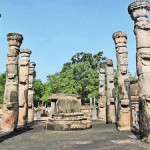An entrepreneurial motivation from our own Sri Lankan ancestors for a better tomorrow
View(s):“The ones who are crazy enough to think they can change the world are the ones who do” is a world-renowned statement made by Mr. Bill Gates the legendary entrepreneur.
The modern world is rapidly changing, and it is unmistakable that entrepreneurship is the driving factor which pushes the world to reach the future through improving for the betterment by changing the status quo every single day from the past to the present.
But the words “entrepreneurship” and “entrepreneur” are not properly defined in the mindset of many people around the world and especially in Sri Lankans.
- Vishmithan Nagendran
- Nathasha Gunatilleke
- Anne Tharushi Fernando
The concept of entrepreneurship is not merely about creating new businesses and new products, but it rather takes a much broader perspective which involves identifying opportunities and exploiting such opportunities in an innovative and creative manner to fulfil the problems arising in the society. This becomes possible through combining the available resources and hence leading to social & economic wellbeing. Entrepreneurship also involves accepting healthy risks, environmental sensitivity, thinking out of the box and creation of wealth. Sri Lanka had been known as a golden land where entrepreneurship was seen since the earliest eras even though it was not clearly referred by the term “Entrepreneurship” at that time. Although Sri Lanka did not directly involve in creating new businesses ventures, there were many instances where our ancestors displayed their entrepreneurial characteristics.
The ancient architecture of Sri Lanka is a broadly spoken highlight all over the world even at present. The cave temples such as Dambulla cave temple, Mihintale gal vihara and the stupas such as Jetavanarama, Abhayagiri Dagaba, Ruwanwelisaya are great examples for the brilliant architecture which reveals the richness of entrepreneurial characteristics among the ancient Sri Lankans because the construction and planning of these architecture involved high level creative thinking and planning together with the ability to combine the available limited resources in a manner in order to cater the social needs of the citizens. The Nissanka latha mandapaya located in Polannaruwa which is uniquely structured with elevated and beautifully carved stone columns and granite columns is another great example for the level of innovation among the ancient civilization of Sri Lanka.
Also, “kuttam pokuna” which was known to be a bathing tank built by the ancient Sinhalese brings about how the people were dissatisfied with the status quo and wanted to think out of the box in creating something that goes beyond the standards of that time which also proclaim the greatness of the entrepreneur who lived within the soul of the ancient Sri Lankan. Also, the lion mountain “Sigirya” which is even considered as the eighth world wonder has a significant importance as it attracts thousands of tourists every year due to uniqueness of combining nature and human imagination to bring out the vision of a whole kingdom with proper facilities on a simple isolated rock. All these ancient architectures explicitly show the level of entrepreneurial mindset which was evident throughout the history of Sri Lanka.
This concept is evident even up to the present with the gigantic irrigation system consisting with the water collection, storage and distribution in integration with the ancient dams and sluice gates built by the great kings which are still in use. It is also mentioned in the “Mahawansa” how efficient management of water and using them in daily purposes was an enormous problem in the society and how our ancient ancestors identified it and exploited this opportunity to bring in a solution of building great dams such as the Parakrama Samudrya in accordance with the King Parakramabahu’s great statement “let not even a drop of rain water go to the sea without benefiting man”.
Also, it is noteworthy that during his reign our island was known to be the granary of East Asia. In addition to him many other rulers of this island contributed immensely through building tanks such as Tabbowa wewa, Hurulu wewa, Minneriya wewa and many more with the intention of building a self-sufficient economy within Sri Lanka which boasts the rich entrepreneurial culture our island used to possess.
Not only that but also there is evidence that air cooling systems were used in many ancient kingdoms in Sri Lanka through activities such as placing a water dripping system on the ceiling, using wattle for the walls of houses and changing the pictures hung on the walls in accordance with the weather.
During a time where technology was not developed, our ancient folks were proficient in utilizing the available resources in finding solutions to the social problems by being sensitive to the environment just like an entrepreneur in the modern world would do.
Being an island situated in the principal sea trade route which was known as the “silk route”, Sri Lanka indeed participated in international trade and there are many evidences which proves the same. Archaeological evidences of foreign trade goods from Anuradhapura, Sigiriya and Ibbankatuwa shows how business entrepreneurship of Sri Lankans were speeded throughout the world.
Mahavansa mentions that Sena and Guttika the Tamil merchants conquered Sri Lanka suggesting that our country was thriving in international trade. It was mentioned in the ancient scripts that Sri Lanka had exported large ships to other countries for their voyages and for armies.
Further islanders had exported gems, pearls, iron, elephants, rice, ginger, honey, beryl, amethyst, gold, silver, and various spices. Additionally, it is said that Sri Lanka also performed a major role as an intermediary centre for trading between other countries where ancient islanders were able to facilitate those activities while earning for them which also resulted in strong employability levels within the country.
As mentioned earlier, entrepreneurship is not restricted to businesses and trade. Rather it is a broader perspective of creativity and innovation. Sri Lanka is a country that had inherited a great extent of various cultures and artistry from its rich history.
We had a culture and a mindset that immensely valued innovations and creativity. There are many examples in this regard written in ancient books and evidences we can witness even today. One such place would be Ambekke Devalaya which has been built during the reign of King Wickramabahu the third.
The temple is almost entirely made with wood with remarkable wood carvings. It shows how surprisingly innovative the Sri Lankans were. In most of the ancient books it had said that kings and monarchs would personally reward people who would introduce new technologies for using their skills and bringing new arts.
They considered those people and their skills to be treasures of the land. They also considered facilitating artists and improving artwork as a priority. Hence many famous artworks were born in these eras. Further in Sri Lanka we have unique dancing styles which were passed down from generation to generation. We can consider those as a product of creative entrepreneurial lifestyle as well.
Social wellbeing is one of the key purposes of any entrepreneur. The early writings state that since the ancient times Ceylon had been specializing in using medicines and medical procedures to heal different ailments which was then gradually developed in to present ayurvedic culture. In addition to that it is evident that hospitals were maintained with a view to facilitate the wellbeing of the citizens and the hospital plan at the Colombo museum strengthens this fact. Moreover, evidences such as the Ibbankatuwa Megalithic Tombs where the burial rights might have been performed proves that Sri Lanka had a rich culture which was driven by entrepreneurs leading for the social wellbeing of all citizens from birth to death.
However, when we examine our country in the present context it is observed that there is a misconception that entrepreneurship is merely focused about starting a business. But it is noteworthy that entrepreneurship is a massively broad concept that goes beyond the traditional mindset of doing a business. When observing the developed countries in the world it is crystal clear that most of those countries are on the top of the Global Entrepreneurship Index which must have been a great influence in developing those countries to the present condition. Thus, it could be recommended that entrepreneurship should be the best solution to overcome the present adversities in our economy and that entrepreneurship education must be integrated into the curriculum of the Sri Lankan students from the primary education itself.
In a nutshell it is clear without any doubt that entrepreneurship had been in the blood stream of Sri Lankans since the earliest periods. But with the time this motivation has been slowly dissolving.
However, many great entrepreneurs have commented on the importance of entrepreneurship concept saying that if somebody is able to visualize a big dream then that person is already in the path of success.
Therefore, with proper facilitation of entrepreneurship Sri Lanka too can restart the journey towards becoming a developed country by inducing an entrepreneurial mindset within each Sri Lankan for a better tomorrow as our ancestors did.
- Anne Tharushi Fernando,
Nathasha Perera Gunatilleke and Vishmithan Nagendran
(Undergraduates at University of Sri Jayawardenapura – Faculty of Management Studies and Commerce)










